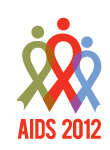 Data from four large cities—San Francisco, Los Angeles, Philadelphia and Chicago—highlight discrepancies in progress towards universal HIV care and help identify cities where interventions may be successfully promoting access to care and treatment, according to new data presented Tuesday, July 24, at the XIX International AIDS Conference in Washington, DC.
Data from four large cities—San Francisco, Los Angeles, Philadelphia and Chicago—highlight discrepancies in progress towards universal HIV care and help identify cities where interventions may be successfully promoting access to care and treatment, according to new data presented Tuesday, July 24, at the XIX International AIDS Conference in Washington, DC.
As explained by lead author Nanette Benbow, MAS, an epidemiologist at the Chicago Department of Health and her colleagues, connection to medical care, continued engagement in health services and treatment adherence are the best way to improve health outcomes for people living with HIV. But in large urban areas, negotiating services is subject to a number of variables that can interfere with city residents’ full engagement in the necessary continuum of care: entry, retention, receiving antiretroviral (ARV) therapy and achieving an undetectable viral load.
For the study, Benbow and her colleagues evaluated a combination of sources to determine the HIV continuum of care in the four cities. Data included all adults diagnosed with HIV in 2008.
Using departments of health surveillance data, the researchers were able to determine how many people were linked to care after being diagnosed in 2008 and were being retained in care through 2009. The researchers considered people in the four cities to be successfully linked to care if they had at least one CD4 or viral load test within three months of being diagnosed. Successful retention in care was defined as those who had CD4 and viral load testing performed in 2009.
The researchers then turned to data from the Medical Monitoring Project (MMP), a surveillance strategy designed to learn more about the experiences and needs of people receiving HIV care, to determine the percentages of 2008-diagnosed individuals who were receiving HIV treatment and those who had undetectable viral loads.
The findings showed that the continuum-of-care rates varied across the four cities.
In terms of successful entry, 68 percent in San Francisco were linked to care compared with 62 percent in Los Angeles, 58 percent in Philadelphia and 54 percent in Chicago. As for successful retention in care, percentages were higher in San Francisco (57 percent) than Los Angeles (54 percent), with Philadelphia (39 percent) and Chicago (30 percent) bringing up the rear.
In terms of those receiving ARV therapy, San Francisco led with 51 percent, followed by Los Angeles (48 percent), Philadelphia (34 percent) and Chicago (26 percent).
The percentage of HIV patients who achieved viral load suppression was highest in San Francisco (44 percent) followed by Los Angeles (40 percent), Philadelphia (23 percent) and Chicago (21 percent).
MMP data across the four cities showed that a higher percentage of whites, compared with blacks, who accessed care were on ARV therapy and virally suppressed. Benbow and her colleagues also found that across cities, blacks, women, and women who have sex with men (WSM, compared with men who have sex with men [MSM]) were less likely to have suppressed viral loads.
In specific cities, females in Chicago and Philadelphia were less likely to be on ARV treatment, compared with males. Blacks, compared with whites, were significantly less likely to be receiving ARV therapy in Los Angeles. Also in Los Angeles, those between 18 and 29 were less likely to be receiving therapy, compared with those 50 years of age and older.
Additionally, blacks and Latinos (versus whites), females, WSM and adults between 18 and 29 were less likely to have suppressed viral loads in Philadelphia. In Los Angeles, rates of viral suppression were lower in females and WSM.
In San Francisco, no significant demographic and sexual behavior differences were noted in the percentage of people on ARV therapy and the percentage of those virally suppressed.
Based on these findings, Benbow and her colleagues concluded that “targeted programs and funding are needed to eliminate racial and ethnic disparities in the provision of [ARV therapy] and viral suppression."
Advertisement
Advertisement
Advertisement






Comments
Comments